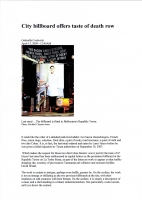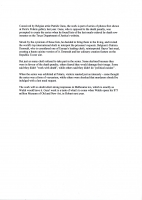Gabriella Coslovich
« City billboard offers taste of death row »
in: Theage.com.au, 2009
.
http://www.theage.com.au
.
.
It reads like the order of a deluded junk-food addict: two bacon cheeseburgers, French fries, onion rings, coleslaw, fried okra, a pint of rocky road icecream, a quart of milk and two diet Cokes. It is, in fact, the last meal ordered and eaten by Larry Hayes before he was given a lethal injection by Texan authorities on September 10, 2003.
Which makes the request for those two diet Cokes bizarre: was it just for the taste of it? Hayes' last meal has been emblazoned in capital letters on the prominent billboard at the Republic Tower on La Trobe Street, as part of the latest art work to appear on that traffic-stopping site, courtesy of provocative Tasmanian art collector and museum builder, David Walsh.
The work is certain to intrigue, perhaps even baffle, passers by. On the surface, the work is not as strange or titillating as the two previous billboards at the site, with their emphasis on odd creatures with bare breasts. On the surface, it is simply a description of a meal, and a chef standing in a bland, industrial kitchen. Not particularly controversial, until you know the context.
Conceived by Belgian artist Patrick Guns, the work is part of series of photos first shown at Paris's Polaris gallery last year. Guns, who is opposed to the death penalty, was prompted to create the series when he found lists of the last meals ordered by death row inmates on the Texas Department of Justice's website.
Struck by the cynicism of those lists, he decided to bring them to the living, and invited the world's top international chefs to interpret the prisoners' requests. Belgium's Patricia Desmedt, who is considered one of Europe's leading chefs, reinterpreted Hayes' last meal, creating a haute cuisine version of it. Desmedt and her culinary creation feature on the Republic Tower site.
But just as many chefs refused to take part in the series. Some declined because they were in favour of the death penalty, others feared they would damage their image. Some said they didn't "work with death", while others said they didn't do "political cuisine" .
When the series was exhibited at Polaris, visitors reacted just as intensely - some thought the series was a form of voyeurism, while others were shocked that murderers should be indulged with a last meal request.
The work will no doubt elicit strong responses in Melbourne too, which is exactly as Walsh would have it. Guns' work is a taste of what's to come when Walsh opens his $75 million Museum of Old and New Art, in Hobart next year.



